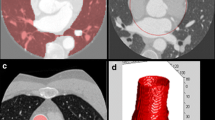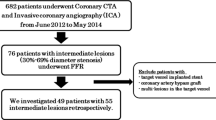Abstract
Objective
To evaluate the performance of a computer-aided algorithm for automated stenosis detection at coronary CT angiography (cCTA).
Methods
We investigated 59 patients (38 men, mean age 58 ± 12 years) who underwent cCTA and quantitative coronary angiography (QCA). All cCTA data sets were analyzed using a software algorithm for automated, without human interaction, detection of coronary artery stenosis. The performance of the algorithm for detection of stenosis of 50% or more was compared with QCA.
Results
QCA revealed a total of 38 stenoses of 50% or more of which the algorithm correctly identified 28 (74%). Overall, the automated detection algorithm had 74%/100% sensitivity, 83%/65% specificity, 46%/58% positive predictive value, and 94%/100% negative predictive value for diagnosing stenosis of 50% or more on per-vessel/per-patient analysis, respectively. There were 33 false positive detection marks (average 0.56/patient), of which 19 were associated with stenotic lesions of less than 50% on QCA and 14 were not associated with an atherosclerotic surrogate.
Conclusion
Compared with QCA, the automated detection algorithm evaluated has relatively high accuracy for diagnosing significant coronary artery stenosis at cCTA. If used as a second reader, the high negative predictive value may further enhance the confidence of excluding significant stenosis based on a normal or near-normal cCTA study.





Similar content being viewed by others
References
Pugliese F, Hunink MG, Gruszczynska K et al (2009) Learning curve for coronary CT angiography: what constitutes sufficient training? Radiology 251:359–368
Choi HS, Choi BW, Choe KO et al (2004) Pitfalls, artifacts, and remedies in multi-detector row CT coronary angiography. Radiographics 24:787–800
Hoe JW, Toh KH (2007) A practical guide to reading CT coronary angiograms—how to avoid mistakes when assessing for coronary stenoses. Int J Cardiovasc Imaging 23:617–633
Nakanishi T, Kayashima Y, Inoue R, Sumii K, Gomyo Y (2005) Pitfalls in 16-detector row CT of the coronary arteries. Radiographics 25:425–438
Wormanns D, Fiebich M, Saidi M, Diederich S, Heindel W (2002) Automatic detection of pulmonary nodules at spiral CT: clinical application of a computer-aided diagnosis system. Eur Radiol 12:1052–1057
de Vries AH, Jensch S, Liedenbaum MH et al (2007) Does a computer-aided detection algorithm in a second read paradigm enhance the performance of experienced computed tomography colonography readers in a population of increased risk? Eur Radiol 19:941–950
Das M, Muhlenbruch G, Helm A et al (2008) Computer-aided detection of pulmonary embolism: influence on radiologists’ detection performance with respect to vessel segments. Eur Radiol 18:1350–1355
Tanaka T, Nitta N, Ohta S et al (2009) Evaluation of computer-aided detection of lesions in mammograms obtained with a digital phase-contrast mammography system. Eur Radiol. doi:10.1007/s00330-009-1505-4
Koss LG, Sherman ME, Cohen MB et al (1997) Significant reduction in the rate of false-negative cervical smears with neural network-based technology (PAPNET Testing System). Hum Pathol 28:1196–1203
Sugahara T, Yamagihara Y, Sugimoto N, Kimura K, Awano K, Azumi T (1992) Computer-aided interpretation of coronary cineangiograms. Accuracy of automatic detection of stenotic lesions. Acta Radiol 33:6–9
Isgum I, Rutten A, Prokop M, van Ginneken B (2007) Detection of coronary calcifications from computed tomography scans for automated risk assessment of coronary artery disease. Med Phys 34:1450–1461
Reimann AJ, Tsiflikas I, Brodoefel H et al (2009) Efficacy of computer aided analysis in detection of significant coronary artery stenosis in cardiac using dual source computed tomography. Int J Cardiovasc Imaging 25:195–203
Das M, Muhlenbruch G, Mahnken AH et al (2006) Small pulmonary nodules: effect of two computer-aided detection systems on radiologist performance. Radiology 241:564–571
Schoepf UJ, Schneider AC, Das M, Wood SA, Cheema JI, Costello P (2007) Pulmonary embolism: computer-aided detection at multidetector row spiral computed tomography. J Thorac Imaging 22:319–323
Zhou C, Chan HP, Patel S et al (2005) Preliminary investigation of computer-aided detection of pulmonary embolism in three-dimensional computed tomography pulmonary angiography images. Acad Radiol 12:782–792
Summers RM, Johnson CD, Pusanik LM, Malley JD, Youssef AM, Reed JE (2001) Automated polyp detection at CT colonography: feasibility assessment in a human population. Radiology 219:51–59
Taylor SA, Iinuma G, Saito Y, Zhang J, Halligan S (2008) CT colonography: computer-aided detection of morphologically flat T1 colonic carcinoma. Eur Radiol 18:1666–1673
Hamon M, Morello R, Riddell JW (2007) Coronary arteries: diagnostic performance of 16-versus 64-section spiral CT compared with invasive coronary angiography—meta-analysis. Radiology 245:720–731
Hendel RC, Patel MR, Kramer CM et al (2006) ACCF/ACR/SCCT/SCMR/ASNC/NASCI/SCAI/SIR 2006 appropriateness criteria for cardiac computed tomography and cardiac magnetic resonance imaging: a report of the American College of Cardiology Foundation Quality Strategic Directions Committee Appropriateness Criteria Working Group, American College of Radiology, Society of Cardiovascular Computed Tomography, Society for Cardiovascular Magnetic Resonance, American Society of Nuclear Cardiology, North American Society for Cardiac Imaging, Society for Cardiovascular Angiography and Interventions, and Society of Interventional Radiology. J Am Coll Cardiol 48:1475–1497
Hoffmann U, Nagurney JT, Moselewski F et al (2006) Coronary multidetector computed tomography in the assessment of patients with acute chest pain. Circulation 114:2251–2260
Hoffmann U, Bamberg F, Chae CU et al (2009) Coronary computed tomography angiography for early triage of patients with acute chest pain: the ROMICAT (Rule Out Myocardial Infarction using Computer Assisted Tomography) trial. J Am Coll Cardiol 53:1642–1650
Sato Y, Matsumoto N, Ichikawa M, Kunimasa T et al (2005) Efficacy of multislice computed tomography for the detection of acute coronary syndrome in the emergency department. Circ J 69:1047–1051
Arnoldi E, Johnson TR, Rist C et al (2009) Adequate image quality with reduced radiation dose in prospectively triggered coronary CTA compared with retrospective techniques. Eur Radiol. doi:10.1007/s00330-009-1411-9
Achenbach S, Marwan M, Schepis T et al (2009) High-pitch spiral acquisition: a new scan mode for coronary CT angiography. J Cardiovasc Comput Tomogr 3:117–121
Conflict of Interest
UJS is a medical consultant for and receives research support from Bayer-Schering, Bracco, General Electric, Medrad, and Siemens. RG is an employee of Rcadia Medical Imaging Ltd. PLZ receives research support from Boehringer-Ingelheim, Bristol Myers Squib, Bracco, and Siemens. PC is a medical consultant for Bracco and receives research support from Siemens.
Author information
Authors and Affiliations
Corresponding author
Rights and permissions
About this article
Cite this article
Arnoldi, E., Gebregziabher, M., Schoepf, U.J. et al. Automated computer-aided stenosis detection at coronary CT angiography: initial experience. Eur Radiol 20, 1160–1167 (2010). https://doi.org/10.1007/s00330-009-1644-7
Received:
Accepted:
Published:
Issue Date:
DOI: https://doi.org/10.1007/s00330-009-1644-7




